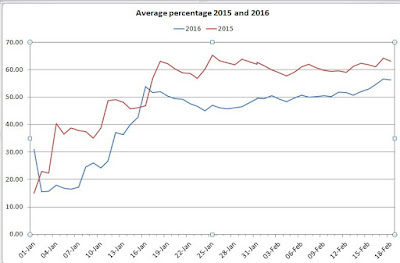Bird a Day 2016
I have again started on a campaign to see a different/new bird each day through 2016. This is my third year (but 4th campaign as I also tried a year starting on 1 July in 2014).
The previous efforts have broken after 162 days (Jan 2014), 173 days (July 2014) and 166 days (Jan 2015). Despite starting in mid-Winter, the July 2014 entry should be higher than the others since that included a 4 week trip to Western and Northern NSW.
So far I am 49 days into the January 2016 effort. My best bird thus far is undoubtedly the Paradise Shelduck seen on January 2: I could also have recorded Hudsonian Godwit (also a BaD 7) on that day, but someone else in the game had scored that on January 1!
Looking at 2016 in contrast with 2015 is interesting. I record two scores for species. The first is called % and is based on the number of times the species has been recorded in NSW by recorders for eBird. Smaller is better as implies rarer. (Its actually an index rather than a percentage, with a high score of 528 for Australian Magpie.) The second is a more subjective rating of rarity requested by Bird-a-Day in which bigger (maximum 7) is better.
Here are some charts:
This indicates that I have generally recorded less common (ie lower %) birds in 2016 than in 2015, which is good as it implies I have got a store of easier birds for later! If I can just get through to when we take some trips away I should easily do better than previous examples - but that means getting a few days longer anyway!
Looking at the BaD scores it appears that introducing scores in locality, rather than all of NSW, gives a slightly different picture as I have pretty consistently been lower - which implies more common birds - in 2016. This is because some of the birds with a low % have also had a low BaD score. For example,
The previous efforts have broken after 162 days (Jan 2014), 173 days (July 2014) and 166 days (Jan 2015). Despite starting in mid-Winter, the July 2014 entry should be higher than the others since that included a 4 week trip to Western and Northern NSW.
So far I am 49 days into the January 2016 effort. My best bird thus far is undoubtedly the Paradise Shelduck seen on January 2: I could also have recorded Hudsonian Godwit (also a BaD 7) on that day, but someone else in the game had scored that on January 1!
Looking at 2016 in contrast with 2015 is interesting. I record two scores for species. The first is called % and is based on the number of times the species has been recorded in NSW by recorders for eBird. Smaller is better as implies rarer. (Its actually an index rather than a percentage, with a high score of 528 for Australian Magpie.) The second is a more subjective rating of rarity requested by Bird-a-Day in which bigger (maximum 7) is better.
Here are some charts:
This indicates that I have generally recorded less common (ie lower %) birds in 2016 than in 2015, which is good as it implies I have got a store of easier birds for later! If I can just get through to when we take some trips away I should easily do better than previous examples - but that means getting a few days longer anyway!
Looking at the BaD scores it appears that introducing scores in locality, rather than all of NSW, gives a slightly different picture as I have pretty consistently been lower - which implies more common birds - in 2016. This is because some of the birds with a low % have also had a low BaD score. For example,
- Hooded Plover has a very low % of 3, but I have also giving it a BaD score of 3 since in Summer they are often seen at the location I ticked.
- Pallid Cuckoo has a % of 7.5 (very low) but I regard them as one of the 'sounds of Summer" in our area so only rate it a 3. In Spring it would probably be a 2.
At the other end of the spectrum a couple of my birds were coded 6 as rare in the Whiskers Creek area but had quite high % scores:
Overall I am optimistic about doing better than in the past. Diversity at home is very good this year, we have a few short trips planned and there are some nice oddities on which I have continued to dip in Canberra (but my luck must change soon)..
- Whistling Kite - possibly the commonest raptor at the coast (thus a % of 136) and not uncommon along the rivers of the ACT - but only recorded a handful of times in 10 years in Carwoola.
- Pelican: code 1 at the coast and on Canberra's Lakes, but only recorded 4 times in 10 years at Carwoola.
Overall I am optimistic about doing better than in the past. Diversity at home is very good this year, we have a few short trips planned and there are some nice oddities on which I have continued to dip in Canberra (but my luck must change soon)..





Comments